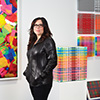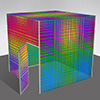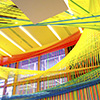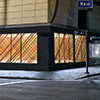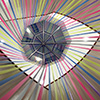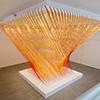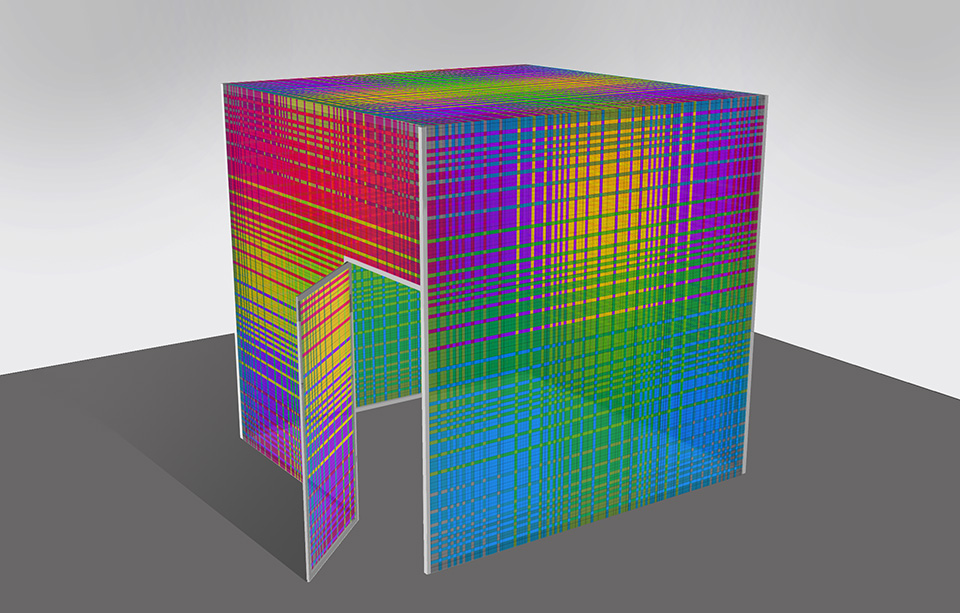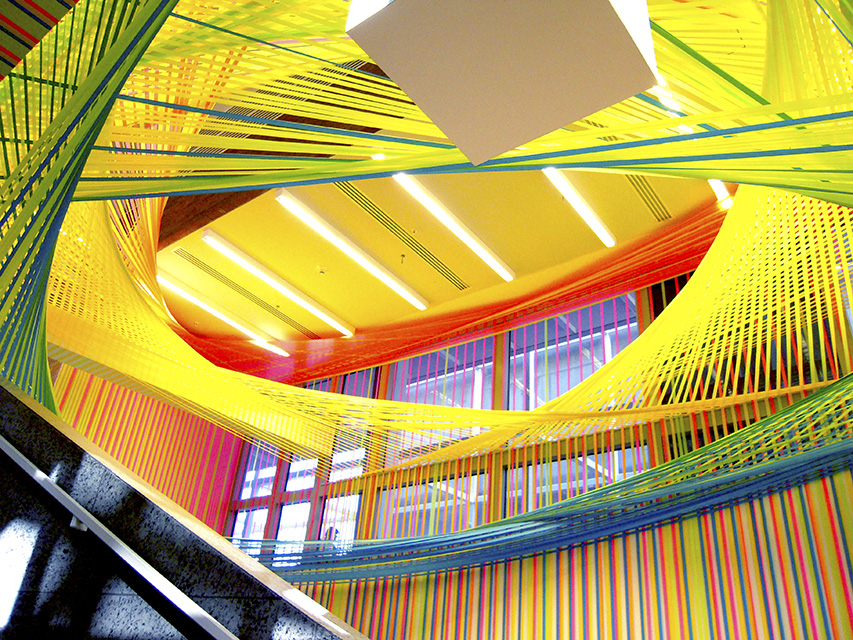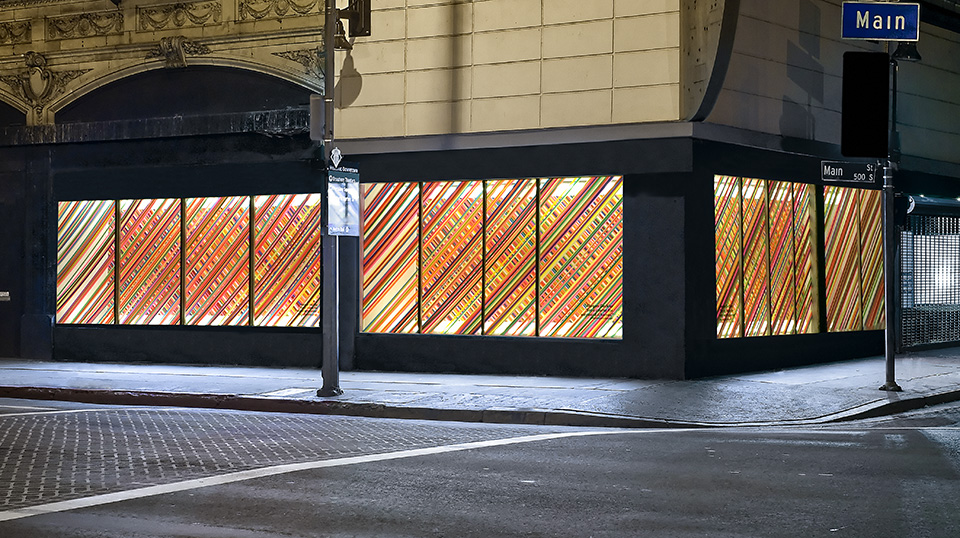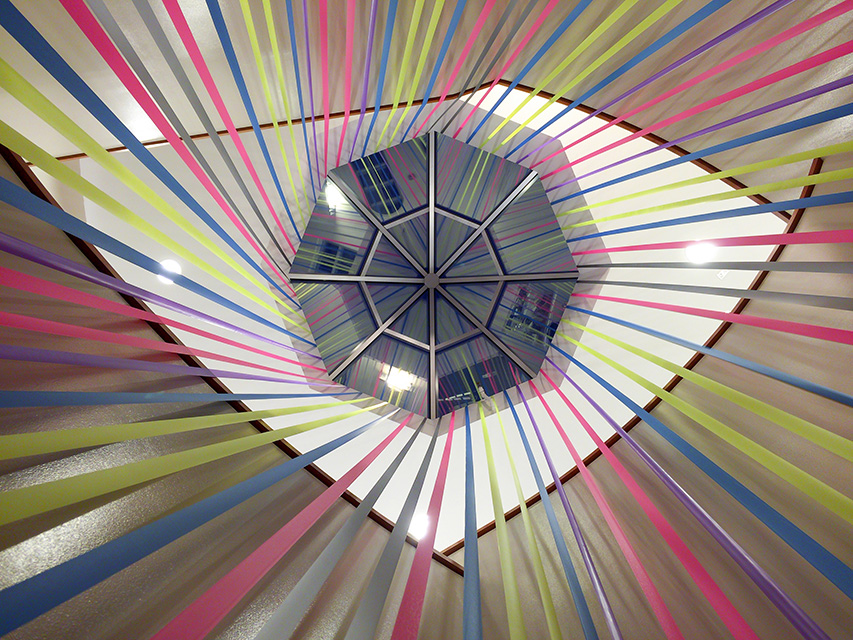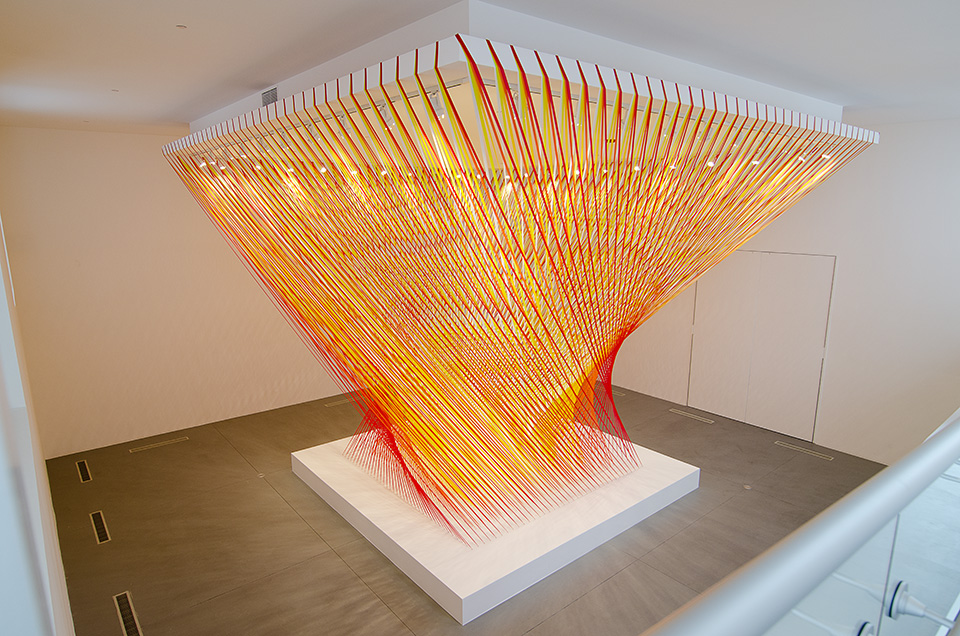Megan Geckler
MEGAN GECKLER: Polychrome Polymath
The actual basis of color is instability. . . . Once you accept that . . . you are dealing with something that is unstable in its basic character, you begin to get a way of dealing with it. –Bridget Riley
One thing that visual art can do that language cannot is to present a unified, singular expression of paradox. In an optical realm of perfect simultaneity derived from an untethered imagination, the laws of physics are entirely optional. But for Megan Geckler, bringing her unique, vibrant architectural installations to fruition means that she really has to do the math. Whether conceiving epic site-specific spatial interventions or self-contained works for floor and wall, Geckler takes real pleasure in the special challenges of materializing the theoretical. Emblematic of her educational background in both advanced mathematics and conceptual art, as well as her sense of humor, everything that this joyful contrarian creates functions simultaneously in multiple dimensions, literally and conceptually.
Her large-scale installations and stretched-canvas pieces evoke the fanciful industriousness of Vladimir Tatlin’s unbuilt monument and are rendered in the saturated artificial colors and defined linear patterns favored by hard-edge artists like Ellsworth Kelly and Frank Stella or op art painters like Bridget Riley and Victor Vasarely. Geckler's graduated woven vortexes, cascading trellises, and atmospheric harmonics are showpieces of aesthetic spectacle, with broad, inclusive appeal and, because of their site-specificity, are never at a loss for surprises. Also, because of their siting and their deliriously complex structure as visible armatures of pure color, they are feats of engineering whose daunting design plans have challenged the most advanced parabolic software on the market. They are among the most rigorous accomplishments of sculptural execution imaginable, the very definition of what it means to activate a space.
Geckler constructs them from flagging tape that she orders from industrial catalogs. She has an affinity for the special properties of nontraditional materials, a slightly obsessive curiosity about their intended functions and their ability to fulfill the goals of high-minded modernism despite their humble origins—and moreover, to expand those goals with a greater soulfulness of meaning and narrative precisely because of the unlikely associations that her unconventional media evoke in their new contexts. "These materials," says Geckler, "seem to enjoy being elevated. Acrylic paint is really just plastic too in the end. But still I feel that it needs to remember what it is and where it came from." In a way, the tape is still working in construction.
Her wall works are small (for her) woven-tape color fields and nuanced patterns. They are thoughtful, emotional, subtly textured abstract paintings in every way save for their lack of paint. Each is derived from a different mathematical algorithm, connecting them in process to her sculptural designs but without the operatic occupation of space. Their aesthetic is jaunty, contemporary, with a certain sense of pixelation, glitchiness, and other postdigital ways of seeing pattern and color. In these works, Geckler takes advantage of making things herself, by hand, and leaves the tied-off tape strips visible on the verso—giving herself permission to indulge in the luxury of imperfection.
Her newest works for the C.O.L.A. exhibition include a set of large-scale photographic prints with the luminosity of stained glass and the settled chaos of allover abstraction. They are pictures of discarded tape cuttings, elevated once again, but instead of the taut rigor and pointed choreography of the sculptures and panels, these lighthearted color studies have the tipsy cheerfulness of confetti at a parade.
Geckler has also constructed a version of the monumental tape installations in the form of a freestanding walk-in cube. "People are always trying to climb inside my pieces," she says, laughing. "And I get it! I want to see one from the inside too, to explore the way the quality of light will affect the translucency and color of the material." Geckler's work has always been experiential, but interactivity at this scale is more than a natural evolution of her ongoing exploration of form and materials; her lofty experiments in light, space, and process are also functional locations for delight and wonderment.
—Shana Nys Dambrot
Megan Geckler
Born 1975, Abington, PA
Lives and works in Los Angeles
Education
MFA, sculpture, Claremont Graduate University, Claremont, CA, 2001
BFA, sculpture, Tyler School of Art, Temple University, Philadelphia, 1998
Glasgow School of Art, Summer Abroad Program, Scotland, 1997
Selected Exhibitions
2016–18 We've got to cross this great big world somehow, Los Angeles International Airport (solo)
2016 Hallucinate and Tranquilize (site-specific installation), Artificial Realities, East Wing Biennial,
Courtauld Institute of Art, London (group)
2013 No chance to look backwards and see, Utah Museum of Contemporary Art, Salt Lake City (solo)
2011 Lay it down and start up, Creative Artists Agency (CAA), Los Angeles (solo)
2010 Spread the ashes of the colors, Wexner Center for the Arts, Columbus, OH (solo)
2010 Every move you make, every step you take, Pasadena Museum of California Art (solo)
Selected Bibliography
Bedford, Christopher. "Megan Geckler—Torrance Art Museum." Artforum, October 20, 2006.
Dambrot, Shana Nys. "The Art of Math." LA Canvas, November–December 2011, 16–17.
DiMichele, David. "AbEx Returns: The Sequel in LA; It's Not Just about Paint Anymore." Artillery,
no. 4 (March–April 2011): 28–32.
Grady, CC. "Women and Their Work, Women in Rock and Roll, and Megan Geckler." Glasstire,
May 2009.
Jobson, Christopher. "A Giant Geometric Vortex of Colored Tape by Megan Geckler." Colossal,
February 21, 2013.
Artist's Website
www.megangeckler.com

